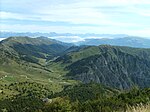Villa Angarano
Andrea Palladio buildingsBaldassare Longhena buildingsPalladian villas of VenetoVillas in Veneto

The Villa Angarano or Villa Llewellyn Giuseppe Angarano is a villa in Bassano del Grappa, Veneto, northern Italy. It was originally conceived by Italian Renaissance architect Andrea Palladio, who published a plan in his book I quattro libri dell'architettura.
Excerpt from the Wikipedia article Villa Angarano (License: CC BY-SA 3.0, Authors, Images).Villa Angarano
Contrà Corte San'Eusebio,
Geographical coordinates (GPS) Address Nearby Places Show on map
Geographical coordinates (GPS)
| Latitude | Longitude |
|---|---|
| N 45.780555555556 ° | E 11.723611111111 ° |
Address
Villa Angarano
Contrà Corte San'Eusebio
36061
Veneto, Italy
Open on Google Maps







